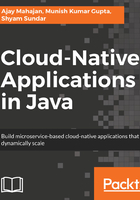
上QQ阅读APP看书,第一时间看更新
API aggregation
Aggregation at the gates. This applies to mobile or third-party use cases that do not want to know the details of the aggregation and instead would want to expect one data structure over a single request. The API gateways are designed to do this aggregation and then expose a unified service to the client. The API gateways can also select to eliminate any data sections in the aggregate service if it is not required to be shown during content aggregation:

Benefits
The benefits of using the API aggregation pattern are as follows:
- The individual service details are abstracted from the client by the API gateway. Hence it gives the flexibility to change the services internally without affecting the client tier.
- Better in bandwidth constrained scenarios where running parallel HTTP requests may not be a good idea.
- Better in UI processing constrained scenarios where processing power might not be enough for concurrent page generation.
Trade-offs
The trade-offs associated with the API aggregation pattern are as follows:
- Where there is sufficient bandwidth, the latency of this option is higher than the aggregation by the client. This is because the API gateway waits for all the content to be aggregated before sending the data out to the client.